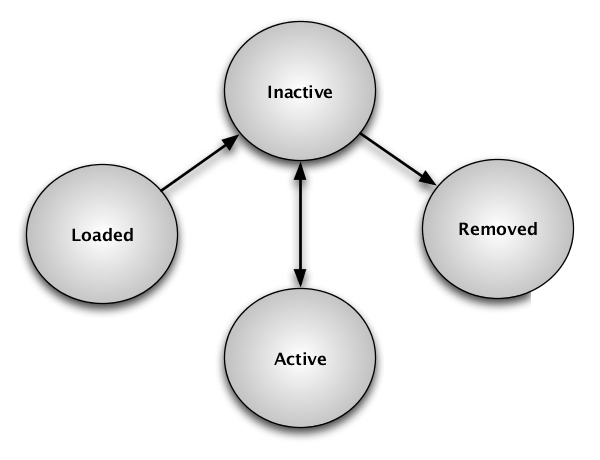All configuration can go through the life cycle shown in Figure 9.2, “Configuration life cycle”.
The possible configuration states are:
Loaded - configuration data has been loaded into a TIBCO BusinessEvents® Extreme node. This is a transient state. The configuration data automatically transitions to the Inactive state once it has been successfully loaded.
Inactive - configuration data is loaded into a node, but it is not the active version.
Removed - configuration data has been removed from the node. This is a transient state.
Only one active version is allowed for each configuration
name within a type. For example
if there are two versions, version 1.0 and version 2.0, of a configuration
file with a name value of
myconfiguration and a type of
distribution, only one can be active at a time in a
node.
An audit step occurs before any configuration state changes to ensure that the configuration change does not cause runtime application failures. If an audit fails, the configuration state change does not occur and the application is left in the previous known good state.
When one version of a configuration type and name is active, and a new version is activated, the old version is replaced. That is, the old version is deactivated and the new version is activated as a single TIBCO BusinessEvents® Extreme transaction. For example, loading and activating version 2.0 to replace version 1.0 takes place as follows:
Configuration type
distributionand namemyconfigurationversion 1.0 is active.Configuration type
distributionand namemyconfigurationversion 2.0 is loaded, passes audit, and is activated.Configuration type
distributionand namemyconfigurationversion 1.0 is now inactive, and configuration typedistributionand namemyconfigurationversion 2.0 is active.
Because the configuration replacement is done in a single TIBCO BusinessEvents® Extreme transaction, there is no disruption to a running application.
Deactivating a configuration version does not restore any previously active version. Another version must be activated, or loaded and activated, as a separate step. (Until this is done, there is no active version.) Nor does deactivating a version unload it; it must be explicitly removed to achieve this. Until removed, a deactivated version remains available to be reactivated again without having to reload the configuration data.
